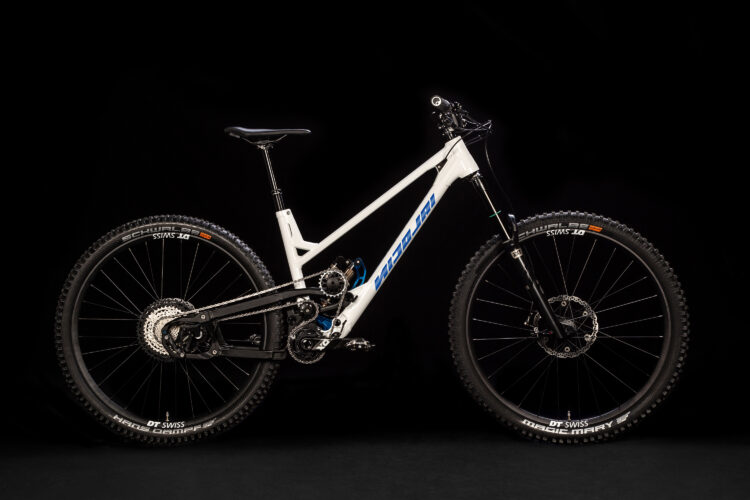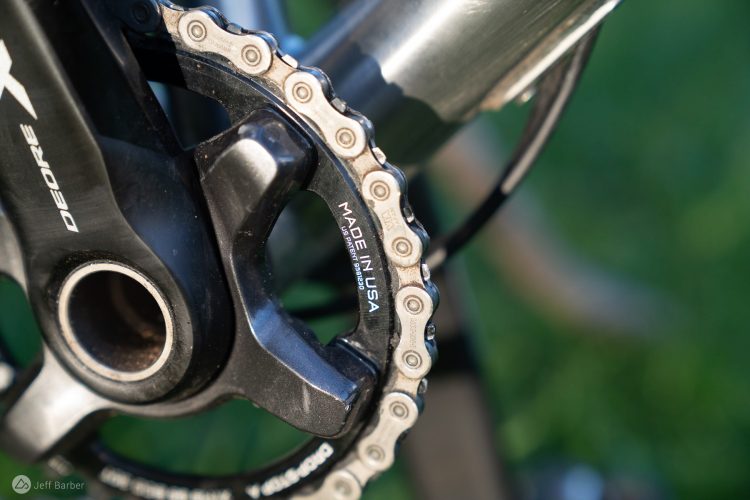
Cedric Eveleigh has built his life around bikes since he was a kid. The 27-year-old grew up in Chelsea, Quebec digging trails and shaping jumps close to home. By high school, he was regularly riding trails, going to mountain bike camps, riding the local bike park, working in bike shops, and studying bikes. By college, he knew what he wanted to do for a living.
“I went into mechanical engineering because of my interest in mountain bikes,” Eveleigh said. “My interest in how mountain bikes work and how they can be improved is 100% the motivation for me studying mechanical engineering.”
Eveleigh graduated with a bachelors degree in mechanical engineering from the University of Ottawa in late 2018 and went on to study engineering physics in a masters program at McMaster University. Shortly after finishing, he dove into his next project: Improving mountain bike drivetrains and derailleurs.
Eveleigh had broken derailleurs before, though not frequently. He knew traditional bicycle drivetrains had advantages, but it seemed like the disadvantages — weight displacement, reliability, and exposure to the elements of the trail — could be reduced. He thought about it and then thought about it some more.
“I was thinking of all kinds of wacky, outside the box solutions and you just have to think of a lot of possibilities and knock them down quickly and then you might get one that works or that’s viable,” he said.

In March of 2019, it came to Eveleigh on a fat bike ride as he stared at his drivetrain during a break in the sun.
“That’s the moment, at that time exactly, when I had the idea that you could separate the chain tensioner from the derailleur, and have it rotating around the bottom bracket axis in the middle of the bike where it’s safe.”
Not only that, it would keep the guide mechanism tucked inside the rear triangle where it’s safe too. Eveleigh picked up his bike and rode home as quickly as he could.
Derailleurs have two main functions and most share the same basic design: The upper (guide) pulley guides the chain side to side, from gear to gear. Its second function is tensioning the chain, which is done at the lower pulley wheel.
Eveleigh questioned the design when he raced home. Would the components fit in a frame? Would the chain lines work? Would the tensioner have enough range of motion?
He put together some CAD models to check the chain lines and quickly built up a bench-top prototype, using cogs from a sawed off cassette, old derailleurs, and other miscellaneous drivetrain components mounted to a mock wooden bike frame. The first rendition worked well enough to build a prototype at home to try it on an actual full-suspension frame.
Eveleigh bought a welder and watched instructional welding videos on YouTube, and before long he had a frame to mount his experimental drivetrain. On the prototype frame, he used a 9-speed, 11-36T cassette. Even though he ran some Finite Element Analysis (FEA) simulations on the frame, he still wasn’t positive it would hold up on an actual ride.
“The focus of my mind on my first ride was the frame actually, because I had never built a frame before,” he said. “But once I moved beyond my concern for the frame’s integrity, then it was just like proper stoke about the fact that the crazy drivetrain was working below me.”
The bike used a simple single pivot design and the first derailleur was made from an old SRAM derailleur that he cut the tensioner arm off of. The design needed some refinement, but it worked well enough for an early, rideable prototype.
Though Eveleigh is skeptical of wide range drivetrains, he knew he needed to add more gears. The next prototype revolved around an 11-speed cassette, but he admits he should have jumped straight to 12. On the new prototype, he moved the idler pulley forward and redesigned the derailleur.
He put a full season on the next prototype, fixed with the 11-speed, 11-45T cassette, and Eveleigh’s friends test rode the bike too. Their reaction affirmed his belief that he was going in the right direction.
“It’s quiet and it feels fast,” they told Eveleigh. “It wasn’t just me being a crazy inventor. It was like, other people are stoked too,” he said.

The Supre Drive holds a few advantages over traditional derailleurs and drivetrains, according to Eveleigh. First, reliability. The derailleur sits inside the frame rather than under the outside of it reducing the opportunities for impact. The derailleur is also fixed to the frame at two points rather than one and doesn’t use a derailleur hanger, nor does it need a B-tension screw.
The chain is higher up on the bike too. On impacts with suspension compression, chains can come close to the ground, increasing the likelihood of a snag or contamination. On the Supre Drive, the chain essentially surrounds the seat stay.
The third advantage is reduced unsprung mass, or less weight that the suspension has to account for. Though Eveleigh says the design adds some weight (100-200g), it’s moved closer to the bottom bracket and farther away from the rear axle.
Compared to a gear box bike, the design keeps the quick, on-the-move shifting properties of a traditional derailleur and it’s also roughly the same weight, whereas gearbox bikes can add more than 2kg in the transmission.
Eveleigh finds the Supre Drive is more efficient than some other high pivot bikes because there is less drag around the idler pulley. The Supre Drive uses a larger pulley and the constant chain tension reduces drag too.
There are a few things about the Supre Drive that some may consider a disadvantage though. The frame obviously needs to be designed around the drivetrain, and it requires SuperBoost axle spacing, while the chainline is 52mm. It’s not possible to throw the components on any ol’ bike a customer might want.


After Eveleigh spent a season on the 11-speed prototype, he got in touch with some bike brands. Nicolai, the German brand known for their long bikes, occasionally built around gearboxes, will be the first to launch a model with Supre Drive. The Nicolai Nucleon 16 is an aluminum, long-travel, high-pivot bike equipped with the drivetrain. And, it will be a 12-speed. He started working with Nicolai shortly after revealing the drivetrain in late 2021. Nicolai hopes to deliver frames to customers by the end of 2022.
Eveleigh’s commitment to 11-speed didn’t last long when he started chatting with bike brands. The gearing is dead as a dodo bird, they told him and the market would have a hard time going back. So, 12-speed it is, and the system works with a Shimano shifter, chain, and cassette. He’ll produce the patented Lal Bikes derailleur, chain tension, and idler pulley at his new headquarters in Sechelt, BC and sell them to companies who want to use the drivetrain.
A few other bike brands have been in touch with Eveleigh about his system and he said at least one other brand is planning to use it on a production model. He recently moved to the Sunshine Coast in B.C. and can ride and test components year round now. It’s been a whirlwind and a step up from building experimental drivetrains in his parents’ basement across the country. He’s excited to reveal the next brand to use the Supre Drive.
“Four months ago, I moved into an industrial space, so I have an industrial workspace. And I just hired my first employee, who is a manufacturing engineer, to join me and help us with manufacturing the drivetrain parts. It’s been a pretty cool experience.”






















4 Comments
Sep 12, 2022
Sep 12, 2022
Sep 14, 2022
Sep 12, 2022
Sep 17, 2022